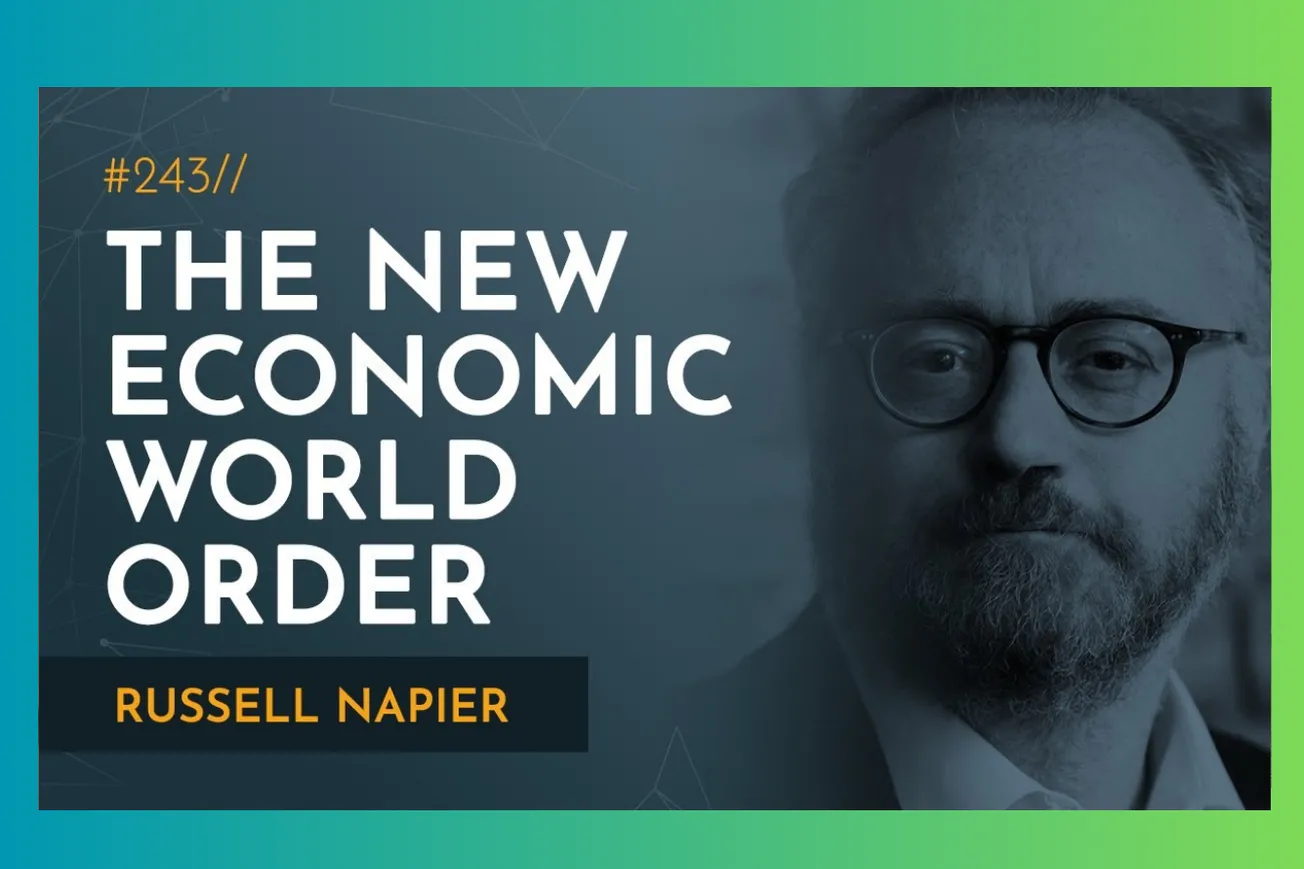Table of Contents
Financial historian Russell Napier explains why asking about central bank interest rates is now the wrong question, and how governments will use financial repression to solve the debt crisis while reshaping the global order.
Key Takeaways
- The most important wrong question investors ask today is "Where will central banks put interest rates?" as monetary policy has become largely irrelevant.
- Central banking failed because banks didn't expand balance sheets despite massive stimulus, creating debt without creating money or inflation until 2020.
- Financial repression will force savers into government bonds yielding below inflation, similar to the post-World War II system from 1945-1979.
- Government control of commercial banking through loan guarantees creates money supply growth and targeted credit allocation to politically favored sectors.
- Capital controls, investment restrictions, and nationalization will return as governments prioritize national security and green transition over market efficiency.
- The US-China cold war will trigger currency regime change when China moves to flexible exchange rates, forcing countries to choose sides.
- Value investing and old-economy manufacturing will outperform as debt-financed financial engineering becomes politically unacceptable.
- Europe faces potential dissolution of the single currency due to rising sovereigntist movements and inability to federalize politically.
- Hold investments in your own name rather than through regulated financial institutions to maintain flexibility as restrictions tighten.
Timeline Overview
- 00:00–14:30 — Introduction and Wrong Questions: Russell Napier's background, why asking about central bank rates is now irrelevant, belief that we live in market system no longer true
- 14:31–28:45 — Old Regime Failure: How the post-Asian crisis system created debt without money growth, central banks lost control of commercial banking, COVID as final catalyst
- 28:46–42:20 — Financial Repression Mechanics: Post-WWII European model returning, forcing savers into below-inflation government bonds, political choices between austerity, default, hyperinflation, or repression
- 42:21–55:35 — Government Control Tools: Capital controls, investment restrictions, nationalization, using emergencies to justify interference with property rights, rationing credit to favored sectors
- 55:36–68:50 — Inflation and Money Creation: How government loan guarantees suddenly made monetary policy work, structural reasons for continued inflation, age of emergencies driving credit allocation
- 68:51–82:05 — Investment Strategy Revolution: Why index investing is dangerous, value investing revival, avoiding debt-financed financial engineering, holding assets in own name for flexibility
- 82:06–95:20 — Geopolitical Architecture: End of hybrid system, China-Russia alliance, currency regime change when China floats exchange rate, countries forced to choose dollar or renminbi system
- 95:21–108:35 — European Crisis: Single currency creating political extremism, sovereigntist movements rising, potential EMU dissolution, Germany in crosshairs of energy and defense problems
- 108:36–121:50 — Asian Cold War Dynamics: Timeline for China's move to flexible rates, exchange rate as line in the sand, most countries likely staying with dollar system
- 121:51–135:05 — World War III Scenario: Proxy wars already beginning, hot flashes likely in Pakistan and other contested regions, cyber and information warfare changing nature of conflict
- 135:06–145:30 — Final Investment Advice: History contains answers to current questions, professional investors lack training in politics and history, importance of understanding regime change
Why Central Bank Policy Has Become Irrelevant
Russell Napier's most provocative assertion is that investors are asking fundamentally wrong questions about the future. Since 1978, when Paul Volcker took control of the Federal Reserve, the key question driving investment decisions has been "Where will central banks put interest rates?" This question shaped portfolio allocation, risk assessment, and market timing for over four decades.
Now, according to Napier, this question has become not just unimportant but actively misleading. Central bankers have lost their primary tool of economic management—control over the commercial banking system. Despite massive stimulus through both low rates and quantitative easing, banks refused to expand their balance sheets and create the money growth necessary for economic reflation.
- From 2009 to 2019, central banks provided enormous liquidity to commercial banks but failed to generate meaningful money supply growth
- Banks, blamed for the financial crisis and constrained by new regulations, simply wouldn't lend despite cheap funding
- The analogy of central bankers as coachmen trying to control horses that refuse to pull the carriage illustrates this loss of control
- Debt continued growing through non-bank channels, but without corresponding money creation, leading to deflationary pressures rather than the intended inflation
The COVID crisis revealed both the final failure of traditional monetary policy and the birth of its replacement. When governments began guaranteeing commercial bank loans, suddenly the banking system responded. Banks could make loans without risk of loss, creating both debt and money simultaneously for the first time since 2008.
This shift represents more than technical monetary mechanics—it marks the transition from central bank control to direct government control of credit allocation. The question is no longer what interest rates central banks will set, but which sectors and activities governments will favor with subsidized credit.
The Return of Financial Repression
The new system emerging is not unprecedented—it mirrors the financial repression that dominated Western economies from 1945 to the early 1980s. This system successfully reduced debt-to-GDP ratios across Europe after World War II through a simple mechanism: forcing savers to hold government bonds yielding less than inflation.
Financial repression requires multiple coordinated policies working together to "corral savings into the killing pens of fixed-interest securities." The toolkit includes capital controls to prevent money from leaving the country, regulations forcing pension funds and insurance companies to hold government bonds, transaction taxes favoring bonds over other investments, and rent controls making property investment less attractive.
- The post-war European model ran from 1945 to approximately 1979, successfully reducing massive government debt burdens
- China has operated a financial repression system and is only slowly backing away from it
- President Nixon implemented price and wage controls in the 1970s, showing that even Republican administrations can embrace non-market policies during crises
- The key difference from recent years is that financial repression requires inflation, which was absent from 2009-2019 but has now returned
The political logic behind choosing financial repression over alternatives like austerity, default, or hyperinflation is straightforward. Austerity requires cutting popular social programs and typically leads to electoral defeat. Default cascades through the financial system, potentially triggering depression-like conditions. Hyperinflation creates random wealth redistribution that destabilizes society unpredictably.
Financial repression, by contrast, appears more subtle and gradual. It slowly transfers wealth from savers to borrowers, including heavily indebted governments, without dramatic immediate disruption. The costs are distributed over time and somewhat hidden, making the policy more politically sustainable than stark alternatives.
The Age of Emergencies and Directed Credit
The structural driver of the new system is what Napier calls "the age of emergencies"—a period where governments identify multiple existential threats requiring immediate intervention. These emergencies justify policies that would otherwise be politically unacceptable interference with private property rights.
Current emergencies include the climate crisis requiring massive green investment, national security threats from China and Russia demanding reshoring of critical industries, persistent health challenges especially in emerging markets, inequality reaching politically dangerous levels, and rising labor costs requiring automation investment.
- President Macron's March 2022 speech outlined explicit French industrial policy with state involvement in financing and running key sectors
- The UK government backed a £600 million loan to Jaguar Land Rover for green vehicle production, showing how climate emergency justifies directed lending
- Each emergency requires specific types of investment that markets might not naturally prioritize, creating rationale for government credit allocation
- The word "emergency" becomes crucial political cover for policies that restrict market mechanisms
This system transforms banking from profit-maximizing intermediaries to quasi-governmental tools for implementing industrial policy. Banks receive government guarantees for loans supporting approved activities while facing restrictions on lending for politically disfavored purposes like financial engineering or property speculation.
The feedback loop becomes self-reinforcing: government guarantees make certain loans risk-free and profitable for banks, encouraging more lending to favored sectors. Meanwhile, regulatory pressure and political rhetoric discourage lending to "socially unproductive" activities, creating credit rationing that doesn't appear in traditional interest rate movements.
Investment Strategy for the New Regime
The investment implications of regime change are profound, requiring abandonment of strategies that worked during the era of central bank dominance. The most dangerous position for investors is passive index investing, which by definition concentrates holdings in the winners of the previous regime—precisely the companies likely to struggle under new policies.
Index funds naturally overweight large, successful companies that have grown through the strategies that financial repression will restrict. Companies that used cheap debt to buy back shares, private equity firms that leveraged existing cash flows, and financial firms that profited from ever-expanding credit markets all face structural headwinds.
- Companies that issued debt to repurchase equity will face restrictions on financial engineering and potential forced re-equitization
- Private equity's debt-fueled model becomes unviable when credit rationing prevents gearing up existing income streams
- Investment banking revenues decline as traditional financial services face political hostility
- Large technology companies may face restrictions if they're viewed as monopolistic or socially harmful
The beneficiaries include old-economy manufacturing that moved to China over the past 30 years but must return due to geopolitical tensions. Steel, chemicals, shipbuilding, defense, and general manufacturing all become strategically important industries likely to receive subsidized government credit.
Value investing—the approach pioneered by Benjamin Graham and practiced by early Warren Buffett—becomes relevant again after years of underperformance. The gap between market valuations and replacement costs of productive assets, which drove value investors from the business, should narrow as financial engineering loses effectiveness.
The Critical Importance of Asset Ownership Structure
One of Napier's most practical recommendations involves how investors hold their assets. The key distinction is between owning investments "in your own name" versus holding them through regulated financial institutions like mutual funds, pension plans, or insurance companies.
The danger of institutional ownership lies in governments' unprecedented power over regulated entities. When 90% of equity markets are owned through institutions compared to 70% individual ownership after World War II, governments can control savings allocation through regulatory changes rather than direct confiscation.
- A law requiring mutual funds to hold 30% government bonds is easier to implement than forcing individual stockholders to sell their holdings
- Pension funds and insurance companies already face regulatory pressure to buy government bonds for "safety" reasons
- Administrative convenience makes institutional holdings attractive until governments begin directing those institutions' investment choices
- Holding 30 individual stocks directly is cumbersome but provides protection from regulatory interference
This recommendation reflects the reality that financial markets have become institutionalized in ways that make government control much easier than in previous eras. The same regulatory apparatus that ensures financial stability can be repurposed to direct capital allocation according to political priorities.
The trade-off between convenience and freedom becomes stark during regime transitions. While holding index funds through tax-advantaged accounts offers simplicity and cost efficiency, it also places investors' wealth under direct government control should policies change.
Geopolitical Architecture and Currency Regime Change
The current global financial system lacks the clear structure of previous arrangements like Bretton Woods or the Gold Standard. Paul Volcker called it "the Hybrid System" because some countries chose to link their currencies while others floated—an unstable arrangement that created the imbalances driving today's crisis.
China's decision to link its currency to the dollar stands as the most consequential policy choice of the past 30 years, more important than any Federal Reserve action. This currency peg created massive trade imbalances, transferred manufacturing capacity to China, and enabled the debt accumulation that now necessitates financial repression.
- The system worked by keeping Chinese labor artificially cheap in dollar terms, making Chinese exports irresistibly attractive
- Massive current account surpluses allowed China to accumulate dollar reserves and effectively subsidize American consumption
- These imbalances created both rising inequality within countries and shifting power balance between countries
- The arrangement became unstable once China's economy reached sufficient scale to challenge American hegemony
The next phase begins when China moves to a flexible exchange rate, abandoning the managed currency system that constrains its monetary policy. This transition will force every country to choose whether to align with a dollar-based system or a renminbi-based alternative.
The choice won't be purely economic—it will determine defense relationships, trade arrangements, and political alignments. Countries that devalue alongside China signal alignment with Beijing, while those maintaining dollar links demonstrate continued Western orientation.
Europe's Multiple Crises and Currency Breakdown
Europe faces the unique challenge of managing financial repression while preserving a single currency system that lacks political integration. The Euro was designed as a "straitjacket" to force political federalization, but this crisis appears to be producing the opposite effect—increasing support for national sovereignty over European integration.
Marine Le Pen polling at 48.5% in France, Viktor Orbán's reelection in Hungary, and similar numbers for sovereigntist parties in Italy demonstrate growing resistance to Brussels-centered power. These movements oppose the very centralization that Euro survival requires.
- The Euro system needs fiscal integration and centralized taxation to function during crises
- Rising sovereigntist parties explicitly reject transferring more power to Brussels
- Jean Monnet's theory that "Europe would be forged in crises" appears to be failing for the first time
- Each government using its banking system to create euros for national purposes undermines central monetary control
Germany finds itself particularly vulnerable as the country that benefited most from the previous system. German machine tool exports to China, cheap Russian energy, and defense provided by America created an economic model that geopolitical reality is dismantling.
The combination of energy dependence on Russia, export dependence on China, and security dependence on America leaves Germany exposed to all three major geopolitical shifts simultaneously. This represents the first European crisis that directly threatens the core rather than peripheral countries.
Timeline and Trigger Events
Napier sees the next major transition occurring within the next few years rather than decades, driven by both domestic Chinese economic pressures and international strategic considerations. China's residential property decline, high debt-to-GDP ratios, and need for monetary policy independence all point toward currency policy changes.
The February 2022 meeting between Xi Jinping and Vladimir Putin before the Ukraine invasion suggests China is more prepared for confrontation than previously assumed. Sanctioning Putin's invasion represented a major risk that implies confidence in China's strategic position.
- China's domestic economic problems may force currency policy changes sooner than strategic considerations alone would suggest
- The property market decline and credit system stress create internal pressure for monetary policy flexibility
- Geopolitical tensions with the US make currency independence increasingly necessary for China
- The Putin meeting suggests Xi Jinping feels ready for increased confrontation with the West
The trigger event will be China's move to a flexible exchange rate, forcing immediate choices by every other country. Malaysia's hypothetical decision to devalue alongside China would prompt immediate American pressure through trade threats, creating the first major test of the new system.
Most Asian countries will likely choose to maintain dollar links rather than align with China, but the decision will be costly and difficult. Countries like the Philippines may find themselves genuinely torn between economic and security considerations.
The Nature of World War III
While avoiding the alarmist language often associated with world war predictions, Napier sees the current period as marking the beginning of a prolonged cold war with periodic hot flashes. The Ukraine conflict already represents a proxy war between NATO and Russia, with weapons and financing flowing from Western countries.
China's continued energy purchases from Russia, especially if European countries cut off supplies, would extend the proxy war dynamic to include Chinese-Western tensions. The conflict could remain primarily economic and political rather than directly military.
- Pakistan's current political instability represents the type of "hot flash" likely to characterize this period
- Cyber warfare and information operations provide new tools for conflict that don't require territorial invasion
- The proliferation of proxy conflicts could make this period more similar to the Peloponnesian War than previous world wars
- Taiwan's island geography makes direct invasion difficult but also prevents the resupply that has sustained Ukraine
The key difference from the Cold War of 1945-1989 is the integration of economic systems that must now be unwound. The previous Cold War began with already separate economic blocs, while today's situation requires actively decoupling intertwined supply chains and financial relationships.
This creates opportunities for unintended escalation as economic warfare spillovers into other domains. The complexity of modern interdependence makes controlled conflict more difficult to maintain than the clearer boundaries of the previous Cold War.
Conclusion and Practical Implications
Russell Napier's analysis reveals that we are living through a regime change as fundamental as the transition from the Gold Standard to Bretton Woods or from Bretton Woods to the floating rate system. The shift from monetary policy to financial repression, from market allocation to government direction of credit, and from unipolar to multipolar geopolitics will reshape everything from individual investment strategies to global trade patterns. Success in this new environment requires abandoning the assumptions that worked during the era of central bank dominance and embracing strategies designed for government-controlled credit allocation. The timeline is compressed—these changes are happening now, not in some distant future, making immediate adaptation essential for preserving and growing wealth in the new order.
Practical Implications:
- Abandon Central Bank Focus: Stop making investment decisions based on Federal Reserve policy; government credit allocation matters more than interest rates
- Hold Assets Directly: Own individual stocks rather than mutual funds to avoid regulatory control over institutional investors
- Avoid Financial Engineering: Sell companies that used debt for share buybacks or private equity strategies dependent on leverage
- Buy Old Economy Manufacturing: Invest in steel, chemicals, shipbuilding, and other industries that must return from China for national security
- Embrace Value Investing: Focus on replacement cost relative to market value rather than growth metrics from the previous regime
- Prepare for Capital Controls: Ensure investments can be converted to your retirement currency; consider where you'll actually spend money
- Monitor European Politics: Watch sovereigntist election results as indicators of Euro system stability and broader political trends
- Build Currency Flexibility: Understand which currency system your investments belong to and how regime change might affect access
Predictions About the World to Come:
- Financial Repression Will Intensify: Governments will increasingly force savers into below-inflation bonds through regulatory requirements and capital controls
- China Will Float Its Currency: Within 2-3 years, domestic economic pressures and strategic needs will force China to abandon managed exchange rates
- Countries Will Choose Sides: Every nation will face binary choice between dollar-based and renminbi-based currency systems, determining broader geopolitical alignment
- European Single Currency Will Fragment: Rising sovereigntist movements will prevent the political integration necessary for Euro survival during crisis
- Proxy Wars Will Proliferate: Ukraine represents the beginning of multiple indirect conflicts as great powers compete through local allies
- Value Investing Will Revive: The gap between market prices and replacement costs will narrow as financial engineering becomes politically unacceptable
- Capital Controls Will Return: Western countries will implement restrictions on capital movement, especially to countries aligned with China or Russia
- Manufacturing Will Reshore: Strategic industries will return to developed countries through subsidized credit and regulatory pressure
- Index Investing Will Underperform: Passive strategies will suffer as they concentrate holdings in companies optimized for the previous regime
- Government Bond Yields Will Stay Low: Financial repression will keep rates below inflation regardless of economic fundamentals or central bank preferences





